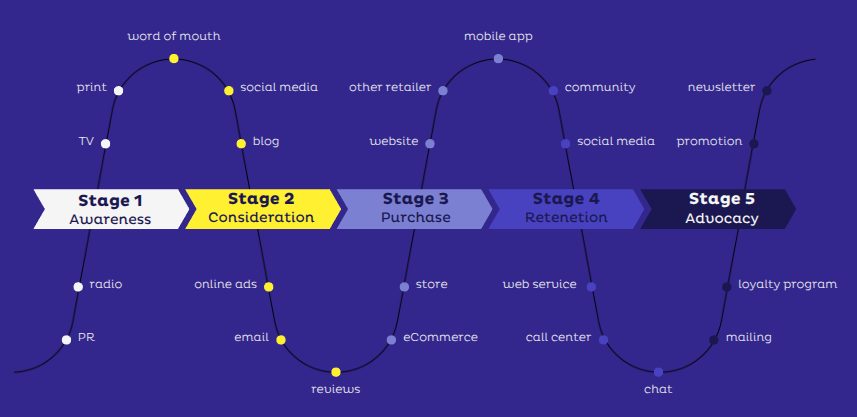The eCommerce market has experienced remarkable growth in recent years, and it’s showing no signs of slowing down. In 2025, the global eCommerce market is set to expand by an impressive 7.8%, reaching a staggering $6.56 trillion. To stay ahead of the competition, ensuring a great customer shopping journey is essential for the success of your eCommerce business. In this article, we’ll explore actionable strategies to optimize every stage of the eCommerce shopping journey.
What is the eCommerce Shopping Journey?
The eCommerce shopping journey, also known as the customer lifecycle, is a multi-stage process that encompasses every interaction a customer has with your brand—from the moment they first hear about you to their ongoing relationship post-purchase. It’s more than just a transaction; it’s a dynamic series of touchpoints designed to attract, convert, retain, and turn your customers into advocates.
Why is the eCommerce Shopping Journey Important?
Understanding the eCommerce shopping journey for your company is very important, because it drives business performance across critical metrics. In fact, companies that focus on improving the customer journey can see impressive results:
- Up to a 50% increase in conversion rates: Streamlining each phase of the customer journey can significantly improve your ability to convert visitors into paying customers.
- Improved Customer Retention. By improving customer loyalty, customers are significantly more likely to purchase again.
- Increased Average Order Value (AOV). Businesses that implement personalized recommendations can see an increase of up to 30% in average order value.
- Higher Customer Satisfaction Rate. Optimized customer journeys lead to smoother experiences, resulting in a higher customer satisfaction rate—critical in an age where, according to eduMe, 86% of customers are willing to pay more for a better experience.
- Improved Customer Lifetime Value. Customers who have a positive shopping experience are more likely to become loyal, repeat buyers, leading to a significant increase in CLV.
These stats highlight why optimizing the eCommerce shopping journey isn’t just a good practice—it’s a business imperative. But to optimize, we must first understand the stages of this journey.
The Stages of the eCommerce Shopping Journey
The eCommerce shopping journey includes five key stages, and understanding each one is vital for crafting a strategy that meets customer needs at every step:
- Awareness. Customers first become aware of a product, often through search engine queries, social media, advertisements, word of mouth, or influencer endorsements.
- Consideration. The customer delves deeper, researching the product, reading reviews, and comparing it with competitors to weigh its value against alternatives.
- Purchase. After thorough evaluation, the customer makes the final decision and completes the purchase.
- Retention. The customer returns for repeat purchases.
- Advocacy. The customer not only continues to buy but actively recommends the product or brand to others.
These stages are not strictly linear—customers often loop back to earlier stages depending on their needs, making it essential to stay engaged and responsive throughout the process.

Optimizing the eCommerce Shopping Journey in 5 Steps
To effectively optimize your customer journey at your eCommerce Website, follow these five steps:
1. Define and Refine Buyer Personas
The first step in creating an effective customer journey map is defining and refining buyer personas. Segment your audience based on demographics, behaviors, preferences, and past interactions, using data from sales, feedback, and support. Regularly update personas to stay aligned with shifting customer preferences, ensuring your marketing efforts are relevant and targeted.
2. Understand Customer Needs, Goals, and Pain Points
Once you’ve defined your personas, dig deeper into understanding their unique needs, motivations, and pain points across the customer journey. Use surveys, interviews, and analytics to gather valuable insights. This will help you identify the challenges customers face at each stage.
3. Identify and Map the eCommerce Customer Journey
Your customers interact with your brand across various touchpoints, from product pages and the shopping cart to checkout and customer support. It’s important to identify these key touchpoints and create an eCommerce customer journey map.
Pro Tip: Download our free Customer Journey Map Template to get started.
4. Track, Analyze, and Measure Customer Behavior
Leverage tools like Google Analytics, heatmaps, and session recordings to track and analyze customer behavior at each touchpoint. By measuring key metrics, such as bounce rates, time spent on pages, and conversion rates, you can gain a deeper understanding of what’s working and what needs improvement.
With Doofinder’s advanced Search tool, you gain invaluable insights into your customers’ pain points, helping you understand the challenges they face while searching for the products they want.
5. Identify and Recome Friction from the Customer Journey
Friction points across any of the stages in the customer shopping journey, such as confusing navigation or unclear product availability, cause customers to hesitate or drop off. Regularly take a look at your eCommerce analytics data to investigate these points and take proactive steps to remove friction from the customer journey, ensuring a smoother experience for your customers.
Online Shopping Journey Pain Points and How to Overcome Them
Now that you have a roadmap for creating and mapping the eCommerce shopping journey, let’s address the most common pain points at each stage of the online purchase journey—and how to overcome them.
Pain Points in the Awareness Phase
During the awareness phase, potential customers may encounter the following challenges:
- Lack of Clear Product Information. Vague or incomplete descriptions can confuse customers. Make sure each product page provides clear, comprehensive information and specifications.
- Overwhelming Choices. Too many options can lead to decision fatigue. Tools like Doofinder’s advanced search and filtering features help guide customers toward relevant products without overwhelming them.
- No Personalization. Generic content makes customers feel like the brand doesn’t cater to their specific needs. Personalizing content ensures a more engaging experience and increases the likelihood of a sale.
Pro Tip: With Doofinder, you can offer personalized product recommendations based on previous searches, browsing habits, and past purchases, making customers feel valued and increasing the likelihood of a conversion.
Pain Points in the Consideration Phase
In the consideration phase, customers may face these pain points:
- Difficulty Comparing Products. Without an intuitive filtering and comparison system, it’s hard for customers to make informed decisions. Using a tool like Doofinder’s advanced search system simplifies this process by offering search filters that help customers compare products easily.
- Unclear Pricing. Ensure that pricing is transparent and easy to understand, so that customers quickly can see the value of each product.
- Confusing Shipping and Return Policies. Provide clear information about shopping costs, delivery timelines and your return policies at every stage of the shopping process.
Pain Points in the Purchase Phase
At the purchase stage, potential customers are ready to buy, but these challenges can still create friction:
- Complicated Checkout Process. Make sure the checkout process has only limited steps. If possible, implement a one-page checkout process.
- Unclear Product Availability. Ensure customers know whether a product is in stock before they reach the checkout. Real-time stock updates are essential.
- Unclear Total Costs. Display the full cost upfront, including shipping, taxes, and discounts, so customers know exactly what they’ll pay.
Solution: With Doofinder, customers can instantly see promotions, free shipping offers, and product availability from search results, making the purchasing process smoother and faster.
Pain Points in the Retention Phase
In the retention phase, the focus is on ensuring that customers return for repeat purchases. Here are some key pain points and their solutions:
- Lack of Post-Purchase Personalization. Provide personalized content, such as follow-up emails, product recommendations, and tailored offers based on previous purchases.
- Unclear Return Processes. Make returns easy and hassle-free by offering clear instructions and pre-paid return labels.
- Lack of Customer Support Access. Offer multiple channels for customer support to address concerns quickly and efficiently.
Pain Points in the Advocacy Phase
At the advocacy stage, the goal is to turn satisfied customers into loyal advocates. Some common pain points include:
- Limited Social Media Engagement. Create opportunities for advocates to share their experiences with their brand and products through social media. You can encourage this by rewarding the most engaged advocates.
- Unclear Benefits of Advocacy. Clearly communicate the value of being an advocate, so that customers fully understand how they can benefit from their efforts.
- Not Enough Social Proof. Encourage and showcase positive reviews from happy customers. Make it easy for customers to leave reviews and share their experiences.
Pro Tip: With Doofinder, you can display product reviews and ratings directly in search results, allowing advocates to easily share their positive experiences, which in turn builds trust and encourages new customers.
The eCommerce Shopping Journey: Future Trends
Future trends of the eCommerce shopping journey will be driven by emerging technologies like AI, machine learning, and automation. These innovations will enable hyper-personalized shopping experiences and real-time recommendations across all touchpoints.
To stay ahead of the curve, consider leveraging tools like Doofinder, which can enhance your site’s search functionality, improve product visibility, and provide personalized recommendations—ensuring a smoother, more engaging shopping experience for your customers. Getting a site search up and running with Doofinder is quick and easy. Start by signing up for a 30-day free trial, or feel free to schedule a demo with one of our eCommerce specialists.
By optimizing each stage of the customer journey, you’ll not only improve your conversion rates and customer retention but also build a strong base of loyal, satisfied customers who will advocate for your brand.










